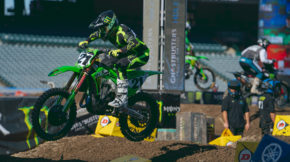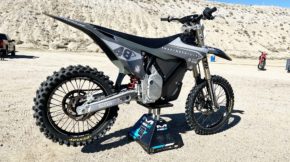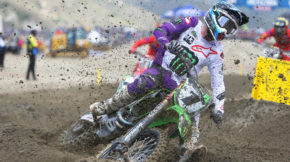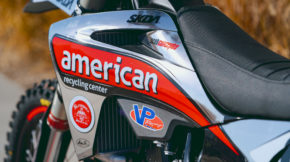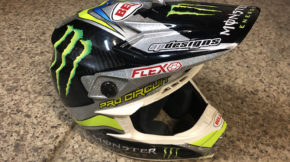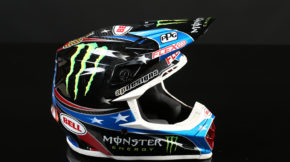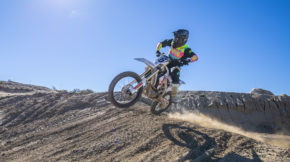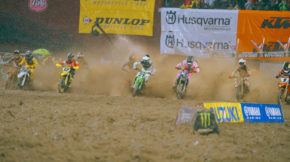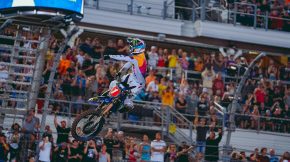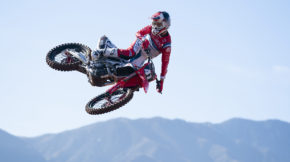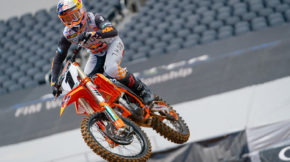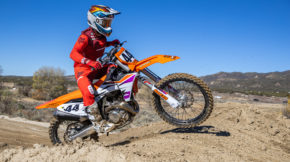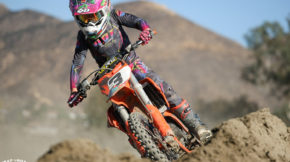Honda Unveils All-New 2022 CRF250R MX Bike!
Share
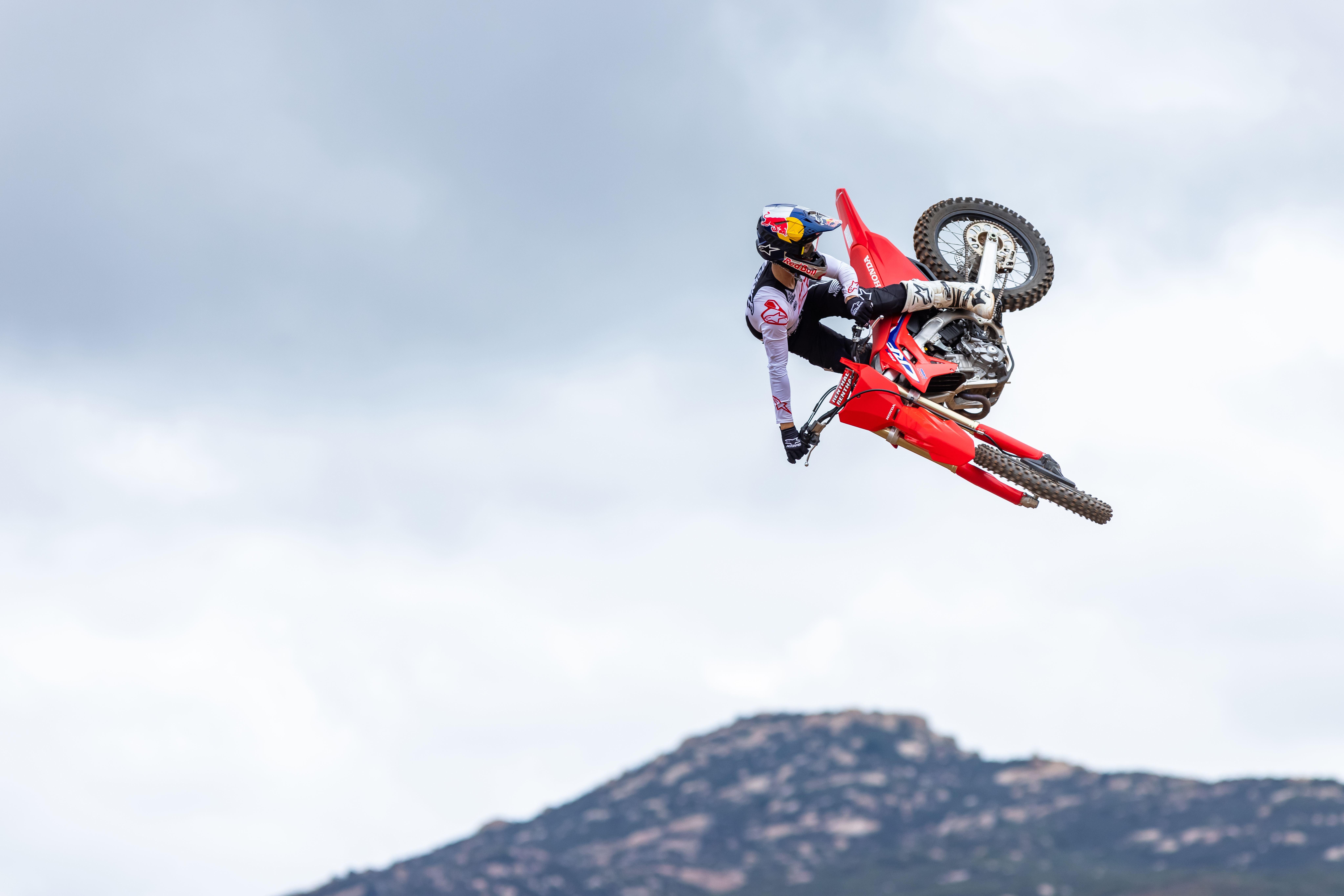
2022 Honda CRF250R
The bike raced by Team Honda HRC riders Jett and Hunter Lawrence, the CRF250R has been completely redesigned for 2022, Honda revealed today. The all-new model features a host of engine and chassis changes leading to improved acceleration on corner exits, increased agility, and better endurance over a race distance.
Since its 2004 introduction, the CRF250R has amassed nine Regional AMA 250SX Supercross titles (including the 2019 and ’20 East Region crowns), plus two AMA 250MX Championships. Phoenix Racing has also won the last three AMA Arenacross titles with the CRF250R, with Kyle Peters going undefeated during the 2021 season. With seven of 12 rounds completed, Jett and Hunter Lawrence have both earned 250MX overall wins in the AMA Pro Motocross series, and they sit second and third in the title chase, respectively.
Nonetheless, Honda engineers weren’t interested in letting the model rest on its laurels for 2022, as they introduced a host of updates that raise the bar for usable power, impeccable handling and robust durability, by boosting engine performance, increasing toughness and cutting weight. The redesigned engine produces more low-rpm torque without sacrificing usable top-end power, resulting in a broader powerband. Chassis updates delivered significant weight savings and improved ergonomics while preserving the model’s renowned handling prowess. A redesigned exhaust system and additional lightened components resulted in a substantial reduction of 8 pounds, for a 229-pound vehicle curb weight. In addition, durability was improved by thoroughly reexamining the engine, its cooling system and the drive components, while notable improvements were also made to the clutch.
“The CRF250R has always been all about racing, and its success record proves that, with top results at the factory level by Jett and Hunter Lawrence, and also in the amateur ranks,” said Brandon Wilson, Sports & Experiential Manager at American Honda. “With reduced weight, increased power where it matters most and improved durability, the all-new 2022 CRF250R is more competitive than ever, and we can’t wait to see what the Lawrence brothers and all Red Riders do with it on motocross tracks across the U.S.”
Each of the CRF250R’s updates is transferred to the 2022 CRF250RX, whose closed-course, off-road realm is the ideal application for the increased low-end power. The CRF250RX also has model-specific features to provide appropriate suspension performance, power delivery, fuel range, hand protection and convenience, making it an appropriate machine for SLR Honda rider Tallon LaFountaine (the reigning AMA NGPC Pro 250 Champion), JCR Honda’s Tarah Gieger and Phoenix Racing Honda GNCC riders Ruy Barbosa and Cody Barnes.
CRF250RIn order to achieve the design goals of increased power and improved durability, the CRF250R’s 249cc liquid-cooled, single-cylinder, double-overhead camshaft four-valve engine is significantly updated, boosting low rpm torque through modification of the air intake, revised valve timing, and a straightened exhaust port with single exhaust header and muffler. Together, the changes deliver a 20% increase in power at 6,500 rpm, while strong top-end power is retained. Meanwhile, the chassis—already exemplary on the previous generation—borrows heavily from that of the latest-generation CRF450R, resulting in reduced vehicle weight. The redesigned frame has optimized flex characteristics, while the modern bodywork facilitates rider movement and is more easily removed. The combination results in reliable tracking, precise turning, exemplary straight-line stability, and overall rideability, thanks in part to an eight-pound-lighter vehicle weight.
- MSRP: $8,099
Since its introduction in 2004, the Honda CRF250R has been the touchstone by which quarter-liter four-stroke competition motocross machines are measured. With the release of each subsequent generation, Honda has brought forth new technologies that redefine the class and set the pace for years to come. Racing successes have steadily accumulated, with the most recent platform earning the 2019 and ’20 AMA Supercross 250SX East crowns at the hands of Chase Sexton, as well as the 2019-’21 AMA Arenacross titles with Jace Owen and Kyle Peters, plus 2021 AMA Pro Motocross 250MX overall wins by Jett and Hunter Lawrence.
That said, it should be no surprise that, rather than resting on its laurels, the 2022 Honda CRF250R is an all-new machine that raises the bar for improved acceleration on corner exits, better endurance over race distance and reduced weight for increased agility.
HISTORY
Just two years after the debut of the CRF450R—Honda’s first four-stroke motocrosser—the original CRF250R was introduced for the 2004 model year. Generation 2 followed in 2006, with a focus on achieving balance through careful vehicle packaging. That bike won the AMA Supercross 250SX East crown at the hands of Davi Millsaps, and two years later Trey Canard took that title aboard the same platform.
The 2010 iteration introduced fuel injection, which Canard employed to good effect in earning that year’s AMA 250 Motocross Championship. Justin Barcia won the following year’s 250SX East crown, and in 2012 Barcia and Eli Tomac dominated AMA Supercross, winning the East and West titles, respectively. In the generation’s final year, Tomac earned the AMA 250 Motocross Championship, with Wil Hahn taking the 250SX East crown.
The model’s 2014 update was noted for its suspension updates, and Justin Bogle rode it to that year’s East Region Championship.
The 2018 model featured a new dual-overhead-cam engine, and Sexton’s aforementioned twin East Region titles proved its effectiveness.
OBJECTIVES
The goal for the 2022 CRF250R design team was ambitious, and to achieve the latest racing evolution, Honda’s engineers focused their efforts on making the model quicker, stronger and lighter, by boosting engine performance, increasing toughness and cutting weight.
Specifically, the redesigned engine produces more low-rpm torque without sacrificing usable top-end power, resulting in a broader powerband.
Significant weight savings was achieved through updates to the chassis, which also boasts improved ergonomics while preserving the handling prowess of its predecessor. That, along with the redesigned exhaust system and additional weight savings on numerous individual components, results in a substantial reduction of 8 pounds for the 2022 CRF250R, to 229 pounds.
Finally, improved durability was accomplished by thoroughly reexamining the engine, its cooling system and the drive components, while notable enhancements were also made to the clutch.
ENGINE / DRIVETRAIN
Improvements to the CRF250R’s 249cc liquid-cooled, single-cylinder, double-overhead camshaft four-valve engine design achieve even greater performance and durability. Significantly, low rpm torque is improved through modification of the air intake, revisions to the valve timing and a straightened exhaust port. The changes result in a 20% increase in power at 6,500 rpm, while strong top-end power is retained.
Intake
Changing the shape of the airbox has increased its capacity by 78%, primarily on the clean side of the air filter. The fuel injector’s lean angle is increased from 30 to 60 degrees, enabling the spray to reach all the way to the back of the butterfly, and the throttle bore is 44 mm. Together these changes better cool the intake charge, improving air-intake efficiency and torque at low revs. An added benefit of the airbox redesign is improved serviceability of the air filter, with a spring-loaded clip replacing the previous threaded design.
Head
Changes to the four-valve cylinder head are numerous. Titanium 33 mm intake and 26 mm exhaust valves are once again utilized, but now the intake valves feature dual springs (one inside the other) to ensure precise movement at higher revs. The intake camshaft sprocket is now press-fit, which improves valve-timing accuracy while reducing weight.
The camshaft holder has a more rigid design that maintains camshaft-journal roundness, contributing to timing accuracy and reduced friction at higher rpm. Valve action at higher revs has been further improved through redesign of the rocker-arm shaft’s alignment. Also, durability at higher engine speeds was enhanced by revising the camshaft’s oil-supply journal, increasing flow by 80%. Oil volume to the cylinder head has also been increased, through a change to the ratio of the oil pump’s driven gear.
Carrying over from 2021, the bore and stroke are 79.0 mm and 50.9 mm, respectively, and the compression ratio is 13.9:1 To take advantage of the numerous cylinder-head improvements, the shapes of the piston and connecting rod have been modified to improve durability at high revs. Also, the water-pump gear is thicker to increase strength.
Exhaust
The exhaust system now utilizes a single straight exhaust port, which improves torque and low-rpm drivability. The single muffler has internal baffling that is optimized for torque delivery, and it contributes to a weight reduction from the previous dual-muffler design. The single exhaust header is now routed 74 mm closer to the engine on the right side, while the left header and muffler have been eliminated, resulting in a narrower cross-section and improved rider mobility.
Electronics
In order to fully realize the engine’s performance potential, the ECU provides all-new mapping to supply the optimum air/fuel mixture and ignition timing at all throttle positions and engine speeds. HRC-inspired launch control facilitates consistent holeshots.
Clutch
Getting all the power to the rear wheel reliably required a redesign of the clutch assembly. The clutch pack now has nine discs instead of eight, which increases the amount of disc friction material and lowers the load on the individual discs. The clutch basket is made more rigid for added durability, an additional friction spring reduces spring load, and lubrication is optimized to reduce wear. The primary ratio is now lower (3.047 vs. 3.473), and lubrication is optimized, improving clutch endurance by 21%. In addition, clutch-engagement feel is enhanced, and lever pull is 4% lighter.
Transmission
Inside the five-speed gearbox, changes were made to reduce friction and improve feel when making up- and downshifts between second and third gears—a very common operation on a 250 motocrosser. Only one shift fork is operated to execute this gear-change (rather than two, as before), the countershaft has improved rigidity, and the shift drum is now 17 percent lighter thanks to a larger through hole and reduction of the number of lead grooves, from three to two.
The improvement results in better gear-shifting feel for the rider, and gear ratios are changed to better utilize the newfound engine power in the low and middle rpm ranges, with first and third being useable across broader speed ranges.
CHASSIS / SUSPENSION
For Honda’s engineers, improving upon the previous CRF250R generation’s exemplary handling was a significant task, as the frame was already known for delivering reliable tracking, precise turning, exemplary straight-line stability and overall rideability. The goals were to ensure that the engine’s newfound power would not upset these traits, and to reduce the overall weight of the machine to facilitate increased maneuverability.
Wheelbase is now 10 mm shorter (at 58.1 inches), rake is relaxed by .02º (to 27.32º), trail remains at 115 mm, the seat height is unchanged at 37.8 inches, and ground clearance is increased by 3 mm (now 13.1 inches).
Frame / Subframe
The aluminum frame is 1.5 pounds lighter for 2022, drawing heavily from the CRF450R. Updates include widely curved main spars with smaller cross-sections, plus optimized rib placement in the backs of the pivot plates. Longitudinal rigidity is maintained for straight-line stability, while lateral rigidity is reduced by 20 percent to enhance handling feel when cornering.
The subframe features a simplified design that enabled the elimination of a separate seat support, achieving a weight reduction of .7 pounds.
Suspension
The coil-spring Showa fork is a 49 mm fully adjustable leading-axle, inverted telescopic design with 12.2 inches of stroke. The upper and lower triple clamps have been redesigned, with rigidity rebalanced via updated reinforcement ribs, delivering increased flex for improved handling and feel through a corner. Traction and bump-impact performance are better as well, and the bike has an agile corner approach, with sharp handling characteristics.
The Pro-Link® rear-suspension system has a revised ratio and uses a Showa shock absorber whose shape has been adapted to work with the new frame, with adjusters moved from the left side to the right. Rear travel is 12.3 inches. An ultra-light steel shock spring contributes to the shock being .24 pounds lighter than last year’s component. The swingarm is also narrower, providing increased clearance in ruts, with rebalanced rigidity tuned to match the frame and improve rear traction and cornering.
Wheels
The black D.I.D rims (21-inch front, 19-inch rear) deliver durable performance and good looks. Petal-style brake rotors (260 mm front, 240 mm rear) disperse heat.
The 2022 CRF250R comes with Pirelli Scorpion MX32 tires, which are ideal for soft and intermediate terrain, and which offer an appropriate amount of sidewall flex for a 250 motocrosser.
DESIGN
Rider-active design is a key feature of the 2022 CRF250R, which inherits many of the design features of the CRF450R. The right and left side panels are 20 mm and 50 mm more inboard, respectively, for a 70 mm narrower cross section at the rear, and the rear portion of the seat is 10 mm lower for a flatter layout. The radiator shroud-side panel junction is smoother as well. These user-friendly ergonomic changes permit the rider to more easily adjust body position when cornering, accelerating, jumping and braking.
The radiator shrouds are new, and each is produced in a single piece instead of two separate parts. Cooling the 2022 CRF250R engine is crucial to maintaining its increased performance and overall durability. Computational Fluid Dynamics (CFD) were used to design air-outlet vents in the shrouds, and the radiator grills were redesigned, optimizing the number of fins, as well as their angle. The radiators’ area of heat radiation was also increased by 6%.
Whereas the seat was previously installed by sliding it forward onto the subframe and then securing it at the rear, the new seat base has rearward-facing tongues and front-located mounting tabs. This arrangement eases installation, and acceleration forces keep the seat securely in place. The 1.7-gallon fuel tank is once again made of lightweight titanium but has a new design, and the plastic tank cover has been eliminated.
Engineers looked for and capitalized on every opportunity to cut weight for improved handling. For example, only eight fasteners are used to secure all of the main bodywork components—both radiator shrouds, both side plates and the seat—instead of 12 as before. In addition, all of the bolts for the main bodywork parts now have 8 mm heads, simplifying maintenance.
As before, the Renthal® Fatbar® handlebar is held by a clamp that can be turned 180º; because the clamp itself has two mounting locations, there are four possible mounting positions for the handlebar, through a range of 26 mm.
CONCLUSION
Honda has once again redefined the 250cc four-stroke motocross competition segment. The 2022 CRF250R showcases the most usable engine performance ever offered in the best handling chassis in its class. Riders of all experience levels will benefit from the machine’s excellent acceleration and sharp cornering, while also appreciating Honda’s legendary durability, quality and reliability.
CRF250RX
For 2022, this bona fide closed-course off-road weapon is all-new, with the same upgrades as the motocross-focused CRF250R. Those changes, which result in reduced weight, more low-end power and improved durability, are particularly well-suited to closed-course off-road series such as NGPC, GNCC and WORCS—the realms of top teams like SLR Honda, JCR Honda and Phoenix Racing Honda. Making the bike even better suited for those applications, the CRF250RX comes standard with model-specific features such as a resin 2.1-gallon fuel tank, dedicated suspension and ECU settings, an 18-inch rear wheel and plastic hand guards.
- MSRP: $8,499
Introduced for the 2019 model year, the first-generation CRF250RX platform has been an excellent choice for professional off-road racers including SLR Honda’s Tallon LaFountaine (2020 AMA NGPC Pro 250 Champion), JCR Honda’s Tarah Gieger (2019 AMA NGPC Pro Women Champion) and Phoenix Racing Honda GNCC rider Cody Barnes. For 2022, this bona fide closed-course off-road weapon is all-new, with the same upgrades as the motocross-focused CRF250R. As such, the machine raises the bar for improved acceleration on corner exits, better endurance over race distance and reduced weight for increased agility.
To tailor it for woods racing, off-road grand prix competition, desert racing and trail riding in legal off-road areas, it has application-specific features to provide appropriate suspension performance, power delivery, fuel range, hand protection and convenience.
OBJECTIVES
The goal for the 2022 CRF250RX design team was ambitious, and to achieve the latest racing evolution, Honda’s engineers focused their efforts on making the model quicker, stronger and lighter, by boosting engine performance, increasing toughness and cutting weight.
Specifically, the redesigned engine produces more low-rpm torque without sacrificing usable top-end power, resulting in a broader powerband and more user-friendly delivery—vital for technical off-road conditions.
Significant weight savings were achieved through updates to the chassis, which also boasts improved ergonomics while preserving the handling prowess of its predecessor. That, along with the redesigned exhaust system and additional weight savings on numerous individual components, results in a substantial reduction of six pounds for the 2022 CRF250RX, to 238 pounds.
Finally, improved durability was accomplished by thoroughly reexamining the engine, its cooling system and the drive components, while notable improvements were also made to the clutch.
MODEL-SPECIFIC FEATURES
Compared to the 2021 CRF250R motocrosser, the CRF250RX has the following differences:
- A resin 2.1-gallon fuel tank (instead of the R model’s 1.7-gallon titanium cell), providing enough range to compete in closed-course off-road competition.
- Both front and rear suspension have dedicated settings developed specifically for closed-course off-road application, for improved compliance over technical terrain like rocks and roots.
- The CRF250RX’s ECU features a different fuel-injection map, with settings that deliver a smooth spread of power, maximizing traction in slippery, off-road conditions.
- Whereas the CRF250R has a 19-inch rear wheel, that of the CRF250RX is an 18-inch size, for a taller tire sidewall that better absorbs obstacles typically encountered off-road. In addition, front and rear tires are Dunlop Geomax AT81, which offer all-around performance plus high levels of ruggedness for off-road racing and riding.
- The CRF250RX comes standard with plastic hand guards, to help fend off trailside bushes and brush. It also has an aluminum side stand, which facilitates parking away from the pits but tucks out of the way when not in use.
ENGINE / DRIVETRAIN
Improvements to the CRF250RX’s 249cc liquid-cooled, single-cylinder, double-overhead camshaft four-valve design achieve even greater engine performance and durability. Significantly, low rpm torque is improved through modification of the air intake, revisions to the valve timing and a straightened exhaust port. The changes result in a 20% increase in power at 6,500 rpm, while strong top-end power is retained.
Intake
Changing the shape of the airbox has increased its capacity by 78 percent, primarily on the clean side of the air filter. The fuel injector’s angle is increased from 30 to 60 degrees, enabling the spray to reach all the way to the back of the butterfly, and the throttle bore is 44 mm. Together these changes better cool the intake charge, improving air-intake efficiency and torque at low revs. An added benefit of the airbox redesign is improved serviceability of the air filter, with a spring-loaded clip replacing the previous threaded design.
Head
Changes to the four-valve cylinder head are numerous. Titanium 33 mm intake and 26 mm exhaust valves are once again utilized, but now the intake valves feature dual springs (one inside the other) to ensure precise movement at higher revs. The intake camshaft sprocket is now press-fit, which improves valve-timing accuracy while reducing weight.
The camshaft holder has a more rigid design that maintains camshaft-journal roundness, contributing to timing accuracy and reduced friction at higher rpm. Valve action at higher revs has been further improved through redesign of the rocker-arm shaft’s alignment. Also, durability at higher engine speeds was enhanced by revising the camshaft’s oil-supply journal, increasing flow by 80%. Oil volume to the cylinder head has also been increased, through a change to the ratio of the oil pump’s driven gear.
Carrying over from 2021, the bore and stroke are 79.0 mm and 50.9 mm, respectively, and the compression ratio is 13.9:1 To take advantage of the numerous cylinder-head improvements, the shapes of the piston and connecting rod have been modified to improve durability at high revs. Also, the water-pump gear is thicker to improve strength.
Exhaust
The exhaust system now utilizes a single straight exhaust port, which improves torque and low-rpm drivability. The single muffler has internal baffling that is optimized for torque delivery, and it contributes to a weight reduction from the previous dual-muffler design. The single exhaust header is now routed 74 mm closer to the engine on the right side, while the left header and muffler have been eliminated, resulting in a narrower cross-section and improved rider mobility.
Electronics
To fully realize the engine’s performance potential, the ECU provides all-new mapping to supply the optimum air/fuel mixture and ignition timing at all throttle positions and engine speeds. HRC-inspired launch control facilitates consistent holeshots.
Clutch
Getting all the power to the rear wheel reliably required a redesign of the clutch assembly. The clutch pack now has nine discs instead of eight, which increases the amount of disc friction material and lowers the load on the individual discs. The clutch basket is made more rigid for added durability, an additional friction spring reduces spring load, and lubrication is optimized to reduce wear. The primary ratio is now lower (3.047 vs. 3.473) and lubrication is optimized, improving clutch endurance by 21%. In addition, clutch-engagement feel is enhanced, and lever pull is 4% lighter.
Transmission
Inside the five-speed gearbox, changes were made to reduce friction and improve feel when making up- and downshifts between second and third gears—a very common operation on a 250 closed-course off-road bike. Only one shift fork is operated to execute this gear-change (rather than two, as before), the countershaft has improved rigidity, and the shift drum is now 17 percent lighter thanks to a larger through hole and reduction of the number of lead grooves, from three to two.
The improvement results in better gear-shifting feel for the rider, and gear ratios are changed to better utilize the newfound engine power in the low and middle rpm ranges, with all gears now being taller, and first and third being useable across broader speed ranges.
CHASSIS / SUSPENSION
For Honda’s engineers, improving upon the previous CRF250RX generation’s exemplary handling was a significant task, as the frame was already known for delivering reliable tracking, precise turning, exemplary straight-line stability and overall rideability. The goals were to ensure that the engine’s newfound power would not upset these traits, and to reduce the overall weight of the machine.
Wheelbase is now 10 mm shorter (at 58.1 inches), rake is relaxed .04º (to 27.15º), trail is 29 mm longer (now 144 mm), the seat height is 5 mm taller (at 38.0 inches) and ground clearance is increased by 5 mm (now 13.2 inches).
Frame / Subframe
The aluminum frame is 1.5 pounds lighter for 2022, drawing heavily from the CRF450RX. Updates include widely curved main spars with smaller cross-sections, plus optimized rib placement in the backs of the pivot plates. Longitudinal rigidity is maintained for straight-line stability, while lateral rigidity is reduced by 20% to enhance handling feel when cornering.
The subframe features a simplified design that enabled the elimination of a separate seat support, achieving a weight reduction of .7 pounds.
Suspension
The coil-spring Showa fork is a 49 mm fully adjustable leading-axle, inverted telescopic design with 12.2 inches of stroke. The upper and lower triple clamps have been redesigned, with rigidity rebalanced via updated reinforcement ribs, delivering increased flex characteristics for improved handling and feel through a corner. Traction and bump-impact performance are better as well, and the bike has an agile corner approach, with sharp handling characteristics.
The Pro-Link® rear-suspension system has a revised ratio and uses a Showa shock absorber whose shape has been adapted to work with the new frame, with adjusters moved from the left side to the right. Rear travel is 12.3 inches. An ultra-light steel shock spring contributes to the shock being .24 pounds lighter than last year’s component. The swingarm is also narrower, providing increased clearance in ruts, with rebalanced rigidity tuned to match the frame and improve rear traction and cornering.
Wheels
The black D.I.D rims (21-inch front, 18-inch rear) deliver durable performance and good looks. Petal-style brake rotors (260 mm front, 240 mm rear) disperse heat.
The 2022 CRF250RX comes with Dunlop Geomax AT81 tires, which offer excellent all-around performance plus high levels of ruggedness for off-road racing.
DESIGN
Rider-active design is key feature of the 2022 CRF250RX, which inherits many of the design features of the CRF450RX. The right and left side plates are 20 mm and 50 mm more inboard, respectively, for a 70 mm narrower cross section at the rear, and the rear portion of the seat is 10 mm lower for a flatter layout. The radiator shroud-side panel junction is smoother as well. These user-friendly ergonomic changes permit the rider to more easily adjust body position when cornering, accelerating, jumping and braking.
The radiator shrouds are new, and each is produced in a single piece instead of two separate parts. Cooling the 2022 CRF250RX engine is crucial to maintaining its increased performance and overall durability. Computational Fluid Dynamics (CFD) were used to design air-outlet vents in the shrouds, and the radiator grills were redesigned, optimizing the number of fins, as well as their angle. The radiators’ area of heat radiation was also increased by 6%.
Whereas the seat was previously installed by sliding it forward onto the subframe and then securing it at the rear, the new seat base has rearward-facing tongues and front-located mounting tabs. This eases installation, and acceleration forces keep the seat securely in place.
Engineers looked for and capitalized on every opportunity to cut weight for improved handling. For example, only eight fasteners are used to secure all of the main bodywork components—both radiator shrouds, both side panels and the seat—instead of 12 as before. In addition, all of the bolts for the main bodywork parts now have 8 mm heads, simplifying maintenance.
As before, the Renthal® Fatbar® handlebar is held by a clamp that can be turned 180º; because the clamp itself has two mounting locations, there are four possible mounting positions for the handlebar, through a range of 26 mm.
CONCLUSION
Honda has set new standards in the 250cc four-stroke closed-course off-road competition segment. The 2022 CRF250RX showcases the most usable engine performance ever offered in the best handling chassis in its class. Riders of all experience levels will benefit from the machine’s excellent acceleration and sharp cornering, while also appreciating Honda’s legendary durability, quality and reliability.
















